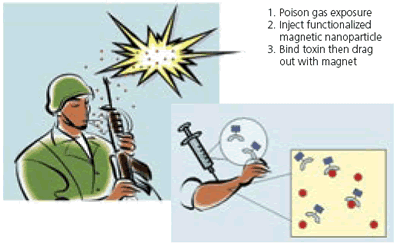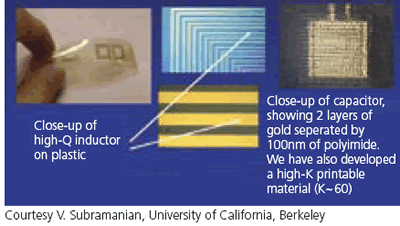|
The detection of chemical and biological warfare agents, radiological agents, and other hazardous vapors has significant import for both the military and homeland security efforts. Small, lightweight, portable, and high sensitive sensors based on nanomaterials are currently being developed and evaluated.
Using Gold Nanoparticles in Sensors for Chemical and Biological Warfare Agents - What This Process Involves
Gold nanoparticles have been investigated for use in sensors for both chemical and biological warfare agents. In one example, ‘chemi-resistors’ comprised of thin films of nanogold particles encapsulated in monomolecular layers of fictionalized alkanethiols deposited on interdigitated microelectrodes reversibly absorb vapors. Monolayer swelling or dielectric alteration in the thin film caused by absorption of the vapor molecules causes a small current. The system appears to have minimal water sensitivity, but can detect harmful vapors down to the parts per billion level or lower. Selectivity of the sensors can be tailored by changing the structure and functionality of the alkanethiol.
Using Nanoparticles in Microchips that Detect Chemical, Biological and Radiological Agents - What this Process Involves
Microchips for detecting chemical, biological and radiological agents that are based on nanoparticles are also being developed. Nanoparticles are laid on a chip, followed by a layer of a special polymer, and then a layer of receptor molecules, with each layer only a few nanometers thick.
In the presence of the warfare agent, a color change occurs. The extent of the color fade is indicative of the gas concentration. With trillions of specific sensor molecules on each chip, detection of only a few molecules of gas could be possible. The chips are designed to be embedded on military vehicles, clothes, buildings and other objects.
Sensors That Use Metal Nanocluster Resonance Technology - Applications and Processes
Sensors that rely on metal nanocluster resonance technology have potential application as detection systems for warfare agents. In these devices, metal clusters that are deposited on a substrate and positioned at a nanometric distance from a wave-reflecting layer act as nanoresonators and are able to receive, store, and transmit energy within the visible and infrared range. The sensitivity can be very high for biorecognition binding as well as structural changes in nucleic acids, proteins, and polymers.
Destruction of Warfare Agents Using Magnetic Nanoparticles and Nanocrystalline Metal Oxides
Destruction of stockpiled warfare agents and decontamination of exposed personnel is equally important to the military and for homeland defense. Both magnetic nanoparticles and nanocrystalline metal oxides have been investigated for this purpose.
Detoxification Processes Using Magnetic Nanoparticles
The use of magnetic nanoparticles to detoxify contaminated military personnel or civilians following a poison gas attack is under investigation by several research groups. Magnetic nanoparticles functionalized to bind with the foreign toxin are injected into the body and drawn through it using a magnetic field gradient. In order for the nanoparticles to be pulled along with the bound toxin molecules, they must have a very high magnetic moment. Gold coated iron, nickel and cobalt ferromagnetic nanoparticles have been employed in this “tag and drag” approach. Researchers are currently searching for cheaper and lighter weight organic coatings.
|

|
|
Figure 1. Diagram showing the 3-step process for detoxifying contaminated military personnel using magnetic nanoparticles.
|
Detoxification Processes Using Metal Oxide Particles and Nanocrstyalline Metal Oxides
Non-toxic nanoscale metal oxide particles have been found to react with and destroy chemical and biological warfare agents. A solventless reactor for the destruction of chemical warfare agents and toxic materials has been designed for use in the non-stockpile chemical demilitarization program. Finely divided nanocrystalline oxides of Zn, Ti, Fe, Mn, and other metals also have potential for destroying old munitions including dissolving their cases corrosively and oxidizing the warfare agents inside.
The nanocrystalline metal oxides, which are semiconductors that are activated by light, mediate the mineralization of chemical weapon agent simulants by oxygen and peroxide. Metal oxide nanocrystals have also been utilized for the destructive adsorption of warfare agents. The nanoparticles, which can be used on both acids and bases, bind to molecules of the hazardous substance and convert it to safer by-products very rapidly.
How Nanoparticles Are Used in Tagging, Tracking and ‘Smart Barcode’ Applications
Tagging and tracking of materials also has potential military and security applications. The use of nanoparticles to create ‘smart’ barcodes is under investigation. Ink containing gold nanoparticles encapsulated in an alkanethiol can be deposited with an inkjet printer in a specific circuit pattern onto paper, plastic, or cloth. The circuits form radio frequency identification (RFID) tags and include both passive (inductors, capacitors, wires) and active (transistors, diodes) components. The heat of the printing process drives off the alkanethiol, leaving behind a concentrated pattern of gold nanoparticles.
|

|
|
Figure 2. Diagram showing close-up views of a high-Q inductor on plastic, and a capacitor with two layers of gold separated by 100nm of polyimide.
|
Using Nanoparticles in Barcodes - Future Applications, Processes and Properties
Another nanoparticle-based barcode system would allow for tagging of very small parts, liquids, or even other particles. In this case, the tags are composed of freestanding cylindrically shaped metal nanoparticles that are self-encoded with sub-micron stripes. The properties of this system enable the creation of libraries of thousands of uniquely identifiable particle types.
Other Applications for Nanomaterials in the Defence and Security Industries
Numerous other potential military and homeland defense applications exist for nanomaterials from Strem. Areas currently under investigation include nanoparticles to make ‘smart’ coating’ on vehicles, nanosensors in light-weight uniforms, sensors to detect life signs, and advanced computing power for code breaking and encryption.
List of Nanomaterials that Strem Can Supply to All Types of Industry
A listing of specific metal nanoclusters, metal nanocolloids (organosols and hydrosols), metal nanopowders, metal nanoparticles, and magnetic fluids offered by Strem is available upon request or via our website. Application sheets discussing the potential use of these products in the medical and pharmaceutical, defense and security, chemical, automotive, and energy fields, and as magnetic fluids, can also be obtained from Strem. More information is also available in the form of a reference sheet listing literature source materials.
|